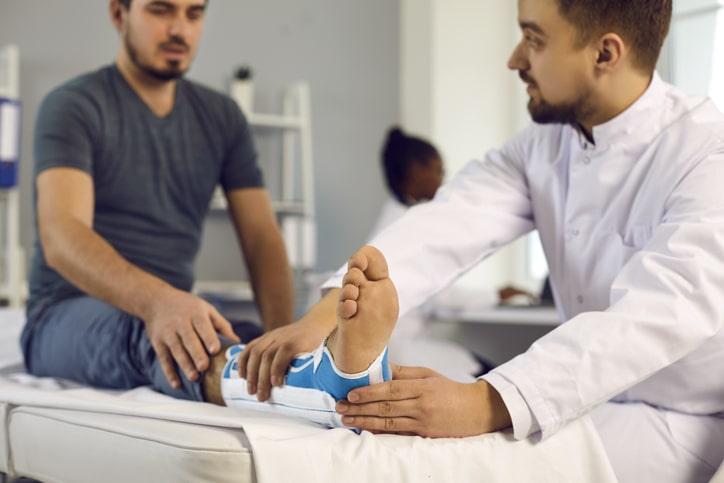Get Our Insider to Property Damage Brochure

Why Traumatic Orthopedic Injuries May Require Long-Term Care
February 29, 2024At Dewey, Ramsay & Hunt, P.A., our Charlotte personal injury attorneys know that traumatic orthopedic injuries involve damage to the musculoskeletal system due to sudden force or trauma, like those that occur in North Carolina accidents.
Traumatic orthopedic injuries can have profound and lasting effects on an individual’s health, function, and quality of life, often necessitating long-term care to address the complex physical, psychological, and social aspects of recovery and rehabilitation.
We understand the lengthy road to recovery that may lie ahead and can include those economic damages in our demand. We can help ensure their injuries are calculated properly — including their current, ongoing, and future medical needs — so they do not have to settle for less.
What are Considered Traumatic Orthopedic Injuries?
Traumatic orthopedic injuries involve damage to the musculoskeletal system caused by sudden force or trauma. These injuries can affect bones, joints, muscles, ligaments, tendons, and other soft tissues.
Common traumatic orthopedic injuries include, but are not limited to:
- Fractures
Fractures, or broken bones, are one of the most common types of traumatic orthopedic injuries. Fractures can vary in severity from simple fractures, where the bone breaks cleanly into two pieces, to complex fractures with multiple fragments or open fractures, where the bone breaks through the skin.
- Crush Injuries
Crush injuries occur when a body part is subjected to extreme pressure or compression, often resulting in damage to bones, muscles, nerves, and blood vessels. Crush injuries can lead to severe tissue damage, compartment syndrome, and other complications.
- Dislocations
Dislocations occur when the bones in a joint are forced out of their normal alignment. This can result in severe pain, swelling, and loss of joint function. Dislocations commonly affect shoulder, elbow, hip, knee, and ankle joints.
- Sprains
Sprains involve damage to ligaments, the rugged bands of tissue that connect bones around a joint. Sprains typically occur when a joint is forced beyond its normal range of motion, leading to stretching or tearing of the ligaments. Common sites for sprains include the ankle, knee, and wrist.
- Strains
Strains involve damage to muscles or tendons, the fibrous tissues connecting muscles to bones. Strains often occur due to overstretching or overloading of the muscle-tendon unit, leading to pain, swelling, and loss of function. Strains commonly affect the back, neck, shoulders, and leg muscles.
- Tendon Injuries
Traumatic orthopedic injuries can also involve injuries to tendons, like tendon tears or ruptures. Tendons attach muscles to bones and are essential for joint movement and stability.
- Soft Tissue Injuries
Traumatic injuries can also affect other soft tissues in the body, including cartilage, fascia, and synovial membranes. Soft tissue injuries may include bruises, cuts, abrasions (scrapes), and damage to internal structures like menisci or bursae.
Traumatic Orthopedic Injuries Often Require Long-Term Medical Care
Traumatic orthopedic injuries may require extensive surgical procedures to repair and stabilize the affected bones and tissues. Unfortunately for those who suffer traumatic orthopedic injuries, surgeries are typically not the end of their recovery needs.
Other factors that increase the length of medical care required for orthopedic injuries include, but are not limited to:
- Recovery Time
Recovery from traumatic orthopedic injuries can be lengthy and may involve multiple stages. Initially, patients may need to immobilize the affected area to promote healing, followed by physical therapy and rehabilitation to regain strength, mobility, and function.
- Complications
Traumatic orthopedic injuries can lead to various complications that may prolong the recovery process and require ongoing medical care. These complications may include infection, nerve damage, chronic pain, stiffness, arthritis, and improper healing of fractures.
- Functional Impairments
Severe orthopedic injuries can result in long-term functional impairments, limiting an individual’s ability to perform daily activities, work, or engage in recreational activities. Long-term care may be necessary to manage these impairments, improve quality of life, and maximize independence.
- Degenerative Changes
Traumatic orthopedic injuries can accelerate degenerative changes in the affected joints and tissues over time. This can lead to ongoing pain, stiffness, and functional decline, requiring ongoing medical monitoring, pain management, and possibly additional interventions, like joint injections or joint replacement surgery.
Depending on the nature and severity of the injury, individuals may need to make significant lifestyle modifications to accommodate their condition. This may include adapting their home environment, using assistive devices, and changing their occupation or recreational activities.
No matter how your orthopedic injuries have impacted your daily activities and overall quality of life, we will calculate them correctly to negotiate the best outcome for your important claim.
Contact Dewey, Ramsay & Hunt for Help Today
If you suffered traumatic orthopedic injuries in an accident caused by negligence in North Carolina, our personal injury attorneys in Charlotte at Dewey, Ramsay & Hunt want to hear your story during a free consultation by calling (704)-377-3737 or contacting us online.
We provide unique legal services tailored to each client’s needs and do not get paid unless you do.
Your Injury, Our Fight. How can we help you take a stand?
Because every case is different, the description of awards and issues previously managed by our law firm does not guarantee a similar outcome in current or future cases.

